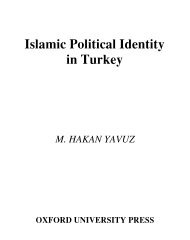Create successful ePaper yourself
Turn your PDF publications into a flip-book with our unique Google optimized e-Paper software.
STATE CORPORATISM AND PLURALIST CHALLENGE 17<strong>in</strong>stitutions [legislatures, the judiciary, <strong>and</strong> political parties] need to l<strong>in</strong>k civilsociety to the state <strong>and</strong> competition needs to be <strong>in</strong>stitutionalised, as well as<strong>in</strong>volve moderation, compromise <strong>and</strong> widespread respect for civil liberties <strong>and</strong>human rights.)Other scholars give an additional explanation of grow<strong>in</strong>g pluralism <strong>in</strong>authoritarian polities. Hoogvelt argues that people’s experience with thestructures of political exclusion <strong>and</strong> poverty, comb<strong>in</strong>ed with structural adjustmentprograms (economic reform), sparked urban movements <strong>and</strong> militant protestactions aga<strong>in</strong>st social <strong>in</strong>justice <strong>and</strong> authoritarianism. In particular, regimeledeconomic reform made under structural adjustment agreements with<strong>in</strong>ternational fund<strong>in</strong>g agencies caused an upsurge <strong>in</strong> associational activism <strong>in</strong>develop<strong>in</strong>g societies, as urban populations were deprived of state support, urbanservices, <strong>and</strong> subsidies. 46 Chazan argues <strong>in</strong> the case of many countries <strong>in</strong> Africathat there was a grow<strong>in</strong>g diversity of associational- activism s<strong>in</strong>ce the adoptionof structural adjustment. 47 In their study of Ch<strong>in</strong>a, Unger <strong>and</strong> Chan note thateconomic reform policies ‘jeopardised’ workers’ benefits <strong>and</strong> led to organisedworker resistance <strong>and</strong> militant actions by the 1990s. 48Thus, middle-class <strong>and</strong> entrepreneurial elements of society, <strong>and</strong> to someextent labour, <strong>in</strong>creas<strong>in</strong>gly conduct their activities outside the tutelage of theexist<strong>in</strong>g corporatist structures, which orig<strong>in</strong>ally were <strong>in</strong>stituted to conta<strong>in</strong>societal pluralism, <strong>and</strong> they compete with, <strong>and</strong> exploit, the weaknesses of theauthoritarian <strong>in</strong>stitutions. 49 With respect to labour, regimes that <strong>in</strong>itiate reformscommonly devolve authority with<strong>in</strong> the centralised corporatist structures to locallevelorganisations, partly <strong>in</strong> response to new economic imperatives <strong>and</strong> partly <strong>in</strong>response to an upsurge <strong>in</strong> compla<strong>in</strong>ts aga<strong>in</strong>st the unrepresentative arrangements.Whereas the goal of the regime <strong>in</strong>variably is to extend its corporatist net oversocial organisation by becom<strong>in</strong>g, or appear<strong>in</strong>g, more responsive to targetconstituencies, relaxation of controls tended to have the opposite effect. Chazannotes that <strong>in</strong> Africa ‘specific groups carved out their own spheres of autonomousaction…[<strong>and</strong>] several officially controlled social <strong>in</strong>stitutions detachedthemselves from state control’. 50 Unger <strong>and</strong> Chan argue that, as Ch<strong>in</strong>a’s centralleadership gradually devolved authority to the regions, corporatist arrangementsshowed signs of shift<strong>in</strong>g from state to societal corporatism. They began to parcelout <strong>in</strong>to more numerous, semi-<strong>in</strong>dependent entities <strong>and</strong> reflect the concerns <strong>and</strong>dem<strong>and</strong>s of their designated membership. In particular, dur<strong>in</strong>g the mid-1990s,‘local union branches broke loose of central control <strong>and</strong> led strikes’. 51 Overall,the different studies address<strong>in</strong>g regime transition <strong>in</strong>dicate that, whereas <strong>in</strong> the1960s <strong>and</strong> 1970s central state (corporatist) controls stunted the development ofautonomous associational life, <strong>in</strong>creas<strong>in</strong>g associational capacity dur<strong>in</strong>g the 1980s<strong>and</strong> 1990s was underm<strong>in</strong><strong>in</strong>g authoritarianism <strong>and</strong> state corporatist structures <strong>in</strong>many develop<strong>in</strong>g countries.Scholars have given different weight to factors responsible for transitions suchas economic liberalisation, crisis, <strong>in</strong>tra-elite rivalry, political reform, socialmobilisation, <strong>and</strong> foreign <strong>in</strong>tervention. There is also debate on the prospect of




